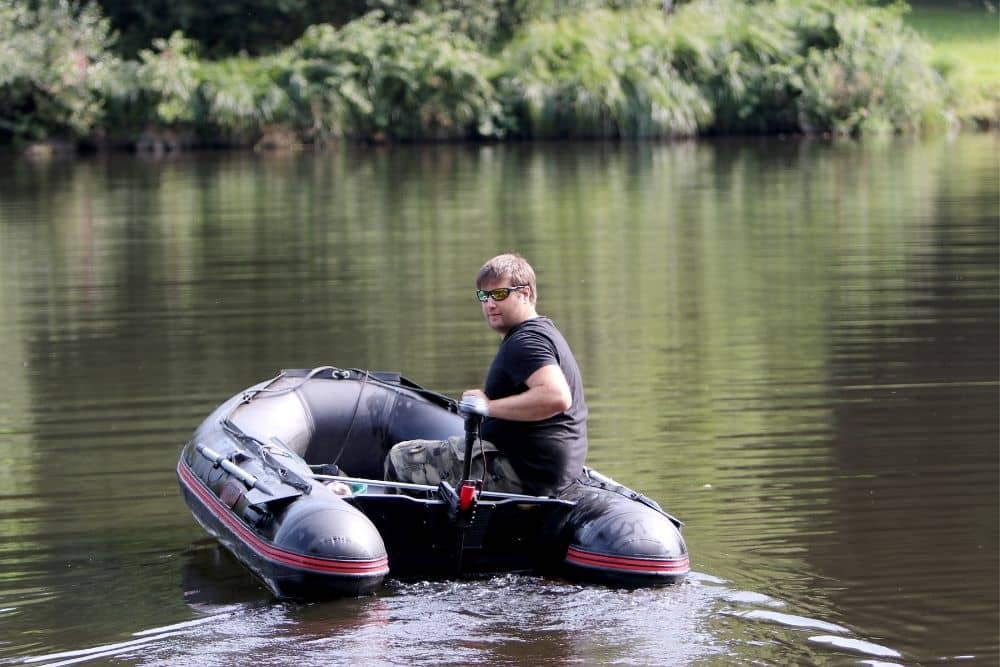Fishing without a trolling motor can make catching a fish incredibly difficult.
Here are a few downsides of NOT using a trolling motor on your fishing trip:
- Lose positioning from the wind and currents
- Unable to explore shallow access
- Fish will notice you and escape due to your boat’s loud engine
Why spin your wheels and spend hours catching a couple of fish?
Using a trolling motor saves you time and energy, allowing you to catch fish by moving through waters without spooking the fish.
All trolling motors are battery-powered.
However, they can be controlled via remote control, by hand or foot pedal.
Today, we’ll cover everything you need to know about operating a trolling motor. We’ll look at:
- How to use a remote control and a hand control trolling motor
- How to steer a foot-controlled motor
- How to fish with a trolling motor
- Handy tips to ensure your trolling motor works effectively
Let’s begin!
Table of Contents
Use a remote control trolling motor

A remote control trolling motor allows you to move the motor by hand using an RC handheld unit.
It provides precise control over your boat, allowing anglers to get great positioning in the waters. Hit the left or right arrow buttons on the device to steer your boat in the desired direction and the plus or minus button to adjust the speed.
There are three types of remote controlling (RC) trolling motors:
- Co-pilot – Able to adjust speed, steer the boat and turn the motor on and off
- Auto-pilot – Adds a compass keeping your inflatable boat on course while moving in cruise control
- iPilot – Uses a real-time GPS system allowing anglers to navigate more precisely to their exact location
With iPilot RC trolling motors, it offers a few advanced smart features such as:
- Go to: Select a point on the map, and your boat will automatically go directly there without the need for steering.
- Spot-lock: Able to hold your boat in place even in the midst of strong currents. This feature is great for fishing in one spot.
- iTracks: Specify a curvy path of up to two miles for your boat to follow. The motor will follow the path given to reach your destination. It’s ideal for trolling banks.
Use a hand control trolling motor

A hand control trolling motor allows you to maneuver your boat by hand. It comes with an ergonomic grip handle that responds to the user’s steering.
This handle or tilt tiller can be steered similar to a steering wheel, except the controls may seem confusing at first.
Pushing the tiller to the right will swing the bow of the boat to the left, and pushing the tiller to the left will move the boat to the right.
Increase the speed of the trolling motor by turning the tiller clockwise, and decrease the speed by turning it counter-clockwise.
You’ll usually feel a click on the tiller handle once you change the speed settings.
Use a foot-controlled trolling motor

First, you’ll need to sit next to the edge of the inflatable boat, typically to the boat’s bow or stern closest to the foot-controlled trolling motor.
Position the foot-controlling trolling motor into the water.
Select and adjust the speed setting that works for your situation. Most trolling motors have a speed setting range between 1 to 5, where 1 is the slowest and 5 is the fastest.
Turn on the trolling motor by pressing your shoe or toe on the foot pedal. There are momentary or constant control switches on the ends or sides of the pedals, allowing you to choose how you want the motor to move.
This action causes the motor to turn on and begin moving.
The momentary control switch only runs the motor for a short time, while the constant control switch means the motor will run continuously until you decide to turn the motor off.
In terms of steering a foot control trolling motor, it will have a directional arrow placed on the head of the shaft. This arrow indicates the direction that the motor will move the boat. It may be a manual or electric display, depending on the type of motor you have.
Changing directions and steering a foot-controlled trolling motor is quite simple.
Pressing your toe down will turn the propeller and underwater motor right, and pressing your heel down on the pedal will steer your boat left.
Once you’ve positioned the boat to the direction you want to move towards, release the pedal to start moving straight again. On the Constant mode, you’ll move in a straight line by default.
Push your heel up or down to change directions anytime and alter your course. It’s best to practice steering to get a feel for the amount of pressure needed to be applied when turning.
Also, in shallow waters, it’s best to start off with slower speeds first. Excessive powers may instantly scare the fish away.
How to fish with a trolling motor?
Electric trolling motors move slower and more quietly, allowing anglers to catch fish efficiently.
When fishing with a trolling motor, your lure will be pulled at a constant rate along the waters rather than casting and retrieving.
First, use a bait that initiates an action when moving, such as swimbaits, spinnerbaits, and crankbaits. Avoid using worms or jigs.
The trolling motor’s speed should be set to where the lure is jiggling or the blades are spinning.
Cast your lure as far as possible and start your trolling motor. The motor will slowly pull you towards the lure.
Navigate to any structures such as bodies of weed lines until you feel a strike.
This is an efficient way to cover a lot of water and find spots that are ripe for fishing. Once you’ve found an area with bites, go ahead and cast your lures as usual.

Fight against strong winds
There’s nothing worse than feeling a bite only to be blown off your spot by a strong gust of wind.
Fighting through over 20 miles of wind while battling white caps isn’t going to be fun.
Sure, you can drop an anchor, but they can be extremely dangerous and heavy, especially in bad weather conditions.
A trolling motor helps you stay put so that you remain in your spots despite strong winds.
Adjust the motor’s direction and thrust as needed to keep your inflatable boat in a good position.
Cover distance while casting in shallow water
Trolling motors are a savior when it comes to fishing in shallow waters.
They enable anglers to move quietly and slowly without needing to turn on the loud outboard engine.
Let’s say you hook a fish while your lure is out. You’ll need to quietly move and reposition yourself into casting range without spooking the fish.
A trolling motor will provide the extra push in your boat even if currents or wind are against you.
Tips to Ensure the Trolling Motor Works Effectively
Here’s a few tips to remember when operating your trolling motor.
Don’t run through thick weeds

Most trolling motors have propellers that can run through weeds or other vegetation without any problems. However, avoid running through thick weeds.
Too many weeds stuck into the shaft or prop can damage or wear out your motor.
If vegetation is stuck, try to pull them out manually rather than shake them out by moving back and forth.
Be mindful of the batteries
Avoid draining the trolling motor batteries by making it work harder than it needs to.
Do not frequently adjust the speed settings, especially when nearing your fishing spot. Inconsistencies in speed and power can scare the fish away and drain your batteries.
Use an onboard charger and charge your batteries in full before hitting the waters.
Conclusion
It’s extremely simple to use a trolling motor once you get the hang of it.
Follow the steps and guidelines outlined in this blog post to understand how to operate a trolling motor.
No more finding a fish and spooking them away because your engines are too loud.
Once you begin using them, you’ll NEVER go back to fishing without them again!

I created this site to help people – to help you – with your boat problems. Instead of helping one person at a time, I want this website to be the “one-stop-shop” for everyone’s boating concerns. Read more.

